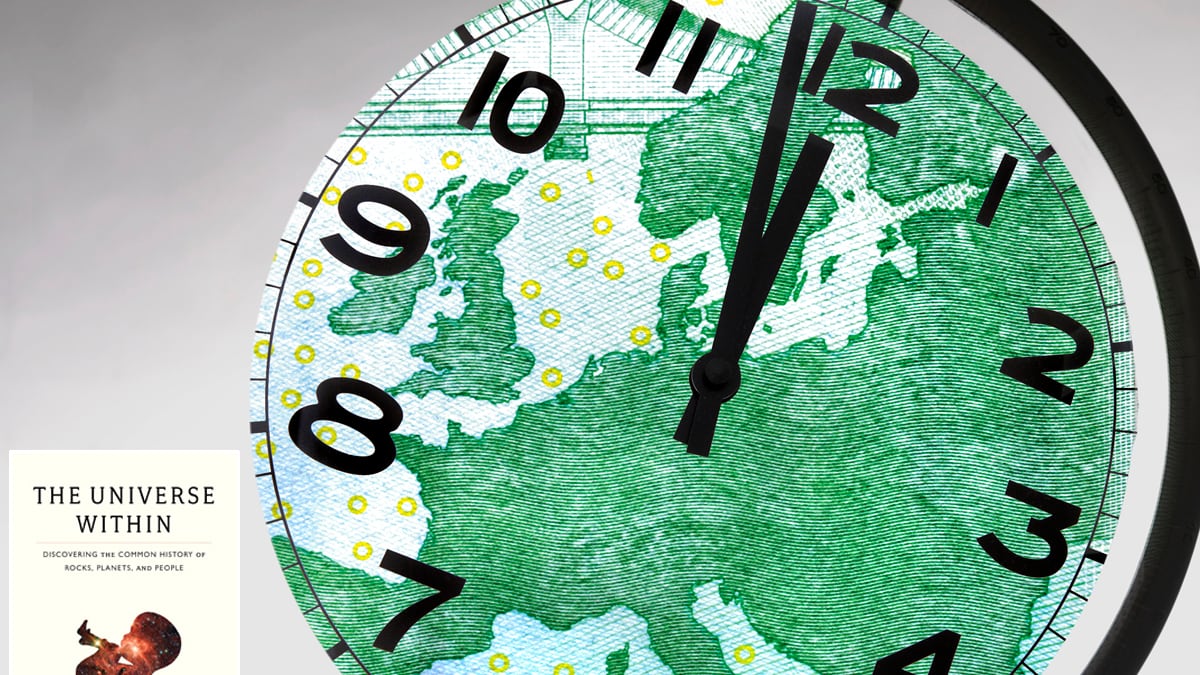The Romans had an effective way of controlling troublesome officials in the far-flung regions of their empire. Instead of gerrymandering districts to stay in power—to help friends and get rid of foes—Caesar and his cronies found the ultimate way to retain control. They gerrymandered the calendar. Have a political friend in one region? Add a few extra days to his term. Want to get rid of a foe in another place? Lop days of his rule off the year. This was wonderfully effective; however, over time, not only did the decentralized calendar make ruling difficult, but the year became a patchwork of political kludges, fixes, and compromises.

The nature of Earth’s rotations in space makes it ripe for these kinds of abuses. We all learn this material in school, but most of us forget the meaning of the planet’s rotations by the time we are in college. A recent survey of Harvard undergraduates asked the simple question: What causes the seasons? Over 90 percent of them got the answer totally wrong. The answer has nothing to do with the amount of light that hits Earth during winter and summer, nor with Earth rocking back and forth, nor with the planet getting closer to the sun over the course of the year.
As we’ve known since the days of Copernicus and his contemporaries, the moon rotates around Earth, while Earth retains its constant 23.5-degree tilt as it rotates around the sun. The angle that sunlight hits the planet changes at different parts of the orbit. Direct light generates the long days and heat of summer; tilted and less direct light gives us shorter and colder winter days. The seasons aren’t generated by Earth rocking back and forth; they derive from the planet having a constant tilt as it rotates around the sun.
Because of the different orbits that affect our lives—ours around the sun and the moon around us—there are choices to make when constructing a calendar. Of course, the length of a year is based on the rotation of Earth around the sun. If we know the longest and shortest days, we can carve up the year into months based on the seasons. Another way to do this is to base the calendar on the position of the moon as it goes from full to partial to new every 29 days. The problem is that you can’t synchronize a lunar calendar with a seasonal, or solar, one. The number of lunar cycles does not correspond easily to the number of seasonal ones.
So what do we do? We add fudge factors. Julius Caesar’s calendar had a leap year every three years to keep the months in line with the seasons. The problem with this calendar for the Catholic Church was the extent to which the date of Easter wandered. To rectify this situation, Pope Gregory XIII initiated a new calendar in 1582. Italy, Spain, and a few other countries launched it immediately following the papal bull, resetting October 4, 1582, to October 15, 1582, losing eleven days. Other countries followed to different degrees. Britain and the colonies, for example, only accepted it in 1752. One of the most important issues to iron out, naturally, was when to collect taxes.
Years, months, and days can, at least in theory, be based on celestial realities, but minutes and seconds are mostly conventions. Our calendar has seven days because of the biblical story of a six-day creation, followed by a day of rest. Minutes and seconds are in units of 60 due to a matter of convenience. The ancient Babylonians had a number system based on 60. It turns out that 60 is a wonderful number because it is divisible by one, two, three, four, five, and six.
Humans are a timekeeping species, and much of our history can be traced to the ways we parse the moments of our lives. These intervals are based as much on astronomical cycles as on our needs, desires, and the ways we interact with one another. When the necessities of shelter, hunting, and survival were highly dependent on days and seasons, humans used timepieces derived from the sun, moon, and stars. Other early timepieces relied on gravity, with hourglasses that used sand or water clocks such as those first seen in Egypt in 4000 b.c. Our need to keep time has itself evolved; an ever-increasing necessity to fragment time corresponds to the demands of our society, commerce, and travel. The concept of moments parsed into seconds would have been as alien to our cave-dwelling ancestors as seeing a jet plane.
There are clocks in our world that do not rely on convention, political choice, or economic necessity. The DNA in our bodies can serve as a kind of timepiece. Averaged over long periods of time, changes to some parts of the DNA sequence happen at a relatively constant rate. This means that if you compare the DNA structure of two species, you can estimate how long ago they shared an ancestor, because the more different the strands of DNA from two species are, the more time they have changed separately. As we’ve seen with zircons, atoms in rocks also tell time. Knowing the ratio of different versions of the elements uranium, argon, and lead can tell us how long ago the minerals in the rock crystallized.
The different clocks in bodies and in rocks don’t tick independently; they are part of the same planetary and solar metronome. Comparisons of the DNA inside humans, animals, and bacteria speak of a common ancestor of all three that lived over 3 billion years ago. This is roughly the age of the earliest fossil-containing rocks. The broad match of dates from rocks and DNA is all the more remarkable given how the rocks have been heated and heaved over the same billions of years that DNA has mutated, evolved, and been swapped among species. Agreement between these different kinds of natural clocks leads to confidence in our hypotheses. On the other hand, discordance between the clocks in DNA and those in rocks can also be the source of new predictions. Whale origins are a case in point. With some of the largest species on the planet, blowholes in the middle of their heads, ears specialized for a form of sonar, and odd limbs, backs, and tails, whales are among the most extreme animals on Earth. Yet, as observers have known for centuries, their closest relatives are mammals: they have hair, mammary glands, and innumerable other mammalian affinities. But which mammals are their closest relatives, and when did whales enter the seas? Comparison of the DNA of whales with that of other mammals revealed that whales likely diverged from odd-toed ungulates such as hippos and deer. The differences in the genes and proteins implied that the split happened nearly 55 million years ago. But this created a whole new puzzle for paleontologists. Not only were there no fossils that showed transitional organs in the shift; there was nothing that ancient with whalelike features in the fossil record. The gap served as a challenge. Vigorous paleontological exploration brought confirmation: the discovery of whale skeletons with ankle bones similar to those of hippos and their relatives inside rocks over 50 million years old. And it all happened by relating the different clocks in rocks and DNA.
Rocks and bodies contain more than clocks: they also hold calendars. Slice a coral, and you will find that the walls of the skeleton are layered with light and dark bands. As they grow, corals add layers of mineral to their skeletons, almost like slapping plaster on a wall. The ways that the mineral forms depend on sunlight, so the variation in the layers refl ects the waxing and waning of each passing day. Mineral growth is fastest in summer, when the days are long, and slowest in winter, when the days are short. Consequently, bands deposited in summer months will be thicker than those at other times of the year. Count the number of layers embedded in each cycle of thick and thin layers, and what do you find? Three hundred sixty-five of them. Coral skeletons can be an almanac of days of the year.
The beauty of corals lies not only in the reefs that reveal the splendor of the underwater world but in the insights they give us into our past. Crack rocks along the sides of roads in Iowa, Texas, even north into Canada, and you will see coral reefs that once thrived in ancient seas hundreds of millions of years ago. The city of Chicago is built upon an ancient coral reef. And reefs like these tell the story of how time itself has changed. Go to fossil reefs 400 million years old, and you will find 400 layers inside the corals—suggesting that each year was actually 400 days long and contained a whopping 35 more days than our current year. What accounts for this discrepancy? Since the duration of a year is fixed by Earth’s rotation about the sun, the days must have been shorter 400 million years ago than they are today. To make the algebra work, each day had to have been twenty-two hours in length. In the eons since those corals were formed, two hours have been added to every day.
Like a slowing top, Earth spins slower and slower with each passing moment, making days longer now than in the past. As the planet rotates, the water in the oceans moves about and serves to brake the spin of the planet. That is why today is two milliseconds longer than yesterday. Fossil corals are silent witnesses to the lengthening of days. Clocks and calendars abound in the natural world, sometimes in the most surprising places.
From the book The Universe Within by Neil Shubin. © 2013 Neil Shubin. Reprinted with the permission of Pantheon Books, an imprint of Knopf Doubleday Publishing Group, a division of Random House, Inc.






